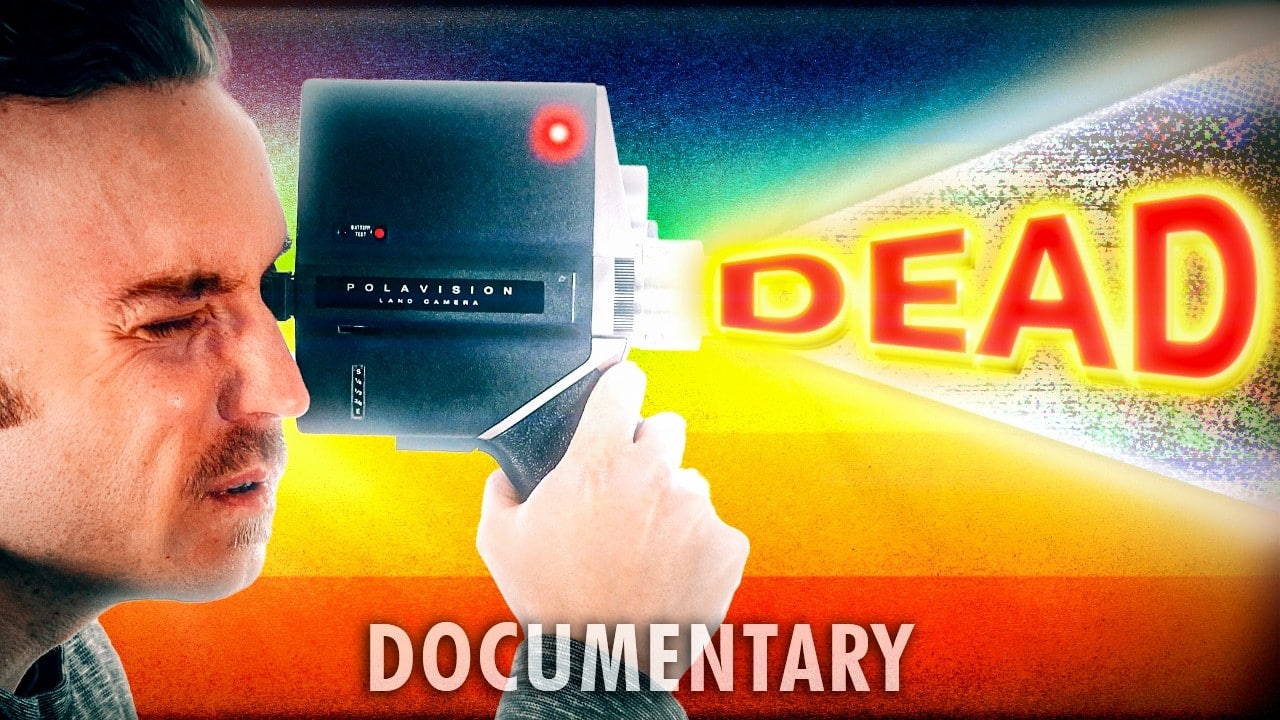Popular Science
What happens to your body when you die in space?
NASA isn’t sure what to do with corpses in space, but they may need to figure it out soon. Of the more than 550 people we’ve sent into the cosmos, just 21 have died—and only 3 actually above the boundary between Earth and space—since humankind first took to strapping ourselves to rockets. When there have…
Popular Science
How to Make a YouTube Video in 1987
Decades before software like Premiere and iMovie made video editing cheap, easy, and accessible for everyone, the only option was chaining a conglomerate of vintage 80s technology – multiple camcorders or VCRs and a TV – to craft custom analog video. Then the Videonics system changed tech history forever. With professional-grade setups costing up to…
Popular Science
The $68 Million Instant Movie Disaster (Polavision)
Nearly 50 years ago, the Polavision camera blended Polaroid’s revolutionary instant film with on-demand home video – and the result was a landmark advance in analog technology that would become a mystery of science and a winding international journey into vintage tech. Because now, generations after Edwin Land bet his half-century legacy of innovation and…
Popular Science
We Mapped a Fly’s BRAIN
A global team of 287 researchers have combined over 100 terabytes of data to create a full map of a fruit fly’s brain, which includes 139,255 individual neurons and 50 million connections. Popular Science, “Scientists mapped every neuron of an adult animal’s brain for the first time”: #science #sciencefacts #weirdscience #biology #research
-

 Science & Technology4 years ago
Science & Technology4 years agoNitya Subramanian: Products and Protocol
-

 CNET4 years ago
CNET4 years agoWays you can help Black Lives Matter movement (links, orgs, and more) 👈🏽
-

 Wired6 years ago
Wired6 years agoHow This Guy Became a World Champion Boomerang Thrower | WIRED
-

 People & Blogs3 years ago
People & Blogs3 years agoSleep Expert Answers Questions From Twitter 💤 | Tech Support | WIRED
-

 Wired6 years ago
Wired6 years agoNeuroscientist Explains ASMR’s Effects on the Brain & The Body | WIRED
-

 Wired6 years ago
Wired6 years agoWhy It’s Almost Impossible to Solve a Rubik’s Cube in Under 3 Seconds | WIRED
-

 Wired6 years ago
Wired6 years agoFormer FBI Agent Explains How to Read Body Language | Tradecraft | WIRED
-

 CNET5 years ago
CNET5 years agoSurface Pro 7 review: Hello, old friend 🧙
















Brendan Hall
April 13, 2021 at 12:20 pm
Not quite what happens when you loose air pressure in space. 🤦🏼
Bridget Connors
April 14, 2021 at 10:21 pm
As opposed to tight air pressure?
Brendan Hall
April 13, 2021 at 12:20 pm
Not quite what happens when you l̶o̶o̶s̶e̶ lose air pressure in space. 🤦🏼
Brendan Hall
April 15, 2021 at 2:56 am
@Bridget Connors Haha thanks. We all make mistakes. Best to acknowledge them, learn and grow from them and keep going. Seeker has some wonderful material but it’s sad to see old myths and misconceptions permeate sci-com
Lurklen
April 17, 2021 at 9:33 am
Yeah, I thought it sounded a bit off. I remember reading a bunch of articles on how the whole “Filling up like a balloon” thing was an exaggeration (because your skin isn’t that elastic) and that it takes longer for the whole blood boiling thing to occur, though the things outside or exposed would start to do so more quickly (one astronaut reported feeling the saliva on his tongue begin to boil before passing out).
iHally
April 13, 2021 at 12:20 pm
Not quite what happens when you l̶o̶o̶s̶e̶ lose air pressure in space. 🤦🏼
iHally
April 15, 2021 at 2:56 am
@Bridget Connors Haha thanks. We all make mistakes. Best to acknowledge them, learn and grow from them and keep going. Seeker has some wonderful material but it’s sad to see old myths and misconceptions permeate sci-com
@i_Hally
April 13, 2021 at 8:20 am
Not quite what happens when you l̶o̶o̶s̶e̶ lose air pressure in space. 🤦🏼
@bridgetconnors8424
April 14, 2021 at 6:21 pm
As opposed to tight air pressure?
@theoriginalbridgetconnors
April 14, 2021 at 6:21 pm
As opposed to tight air pressure?
@i_Hally
April 14, 2021 at 10:56 pm
@@bridgetconnors8424 Haha thanks. We all make mistakes. Best to acknowledge them, learn and grow from them and keep going. Seeker has some wonderful material but it’s sad to see old myths and misconceptions permeate sci-com
@i_Hally
April 14, 2021 at 10:56 pm
@@theoriginalbridgetconnors Haha thanks. We all make mistakes. Best to acknowledge them, learn and grow from them and keep going. Seeker has some wonderful material but it’s sad to see old myths and misconceptions permeate sci-com
@i_Hally
April 14, 2021 at 10:56 pm
@Bridget Connors Haha thanks. We all make mistakes. Best to acknowledge them, learn and grow from them and keep going. Seeker has some wonderful material but it’s sad to see old myths and misconceptions permeate sci-com
@Lurklen
April 17, 2021 at 5:33 am
Yeah, I thought it sounded a bit off. I remember reading a bunch of articles on how the whole “Filling up like a balloon” thing was an exaggeration (because your skin isn’t that elastic) and that it takes longer for the whole blood boiling thing to occur, though the things outside or exposed would start to do so more quickly (one astronaut reported feeling the saliva on his tongue begin to boil before passing out).
Popular Science
April 13, 2021 at 1:53 pm
The article version of this video also includes a part about space cannibalism (obviously)
@popsci
April 13, 2021 at 9:53 am
The article version of this video also includes a part about space cannibalism (obviously)
@popularscience
April 13, 2021 at 9:53 am
The article version of this video also includes a part about space cannibalism (obviously)
Oldscool Gaming.
April 14, 2021 at 11:18 am
WHAT DO YOU MEAN WHEN! is there something your not telling me…. : o
@oldscoolgaming.5040
April 14, 2021 at 7:18 am
WHAT DO YOU MEAN WHEN! is there something your not telling me…. : o
Sweet Tea
April 14, 2021 at 11:48 am
Thanks for sharing
Tracy Webb
April 14, 2021 at 11:48 am
Thanks for sharing
Travelling on Uptozion
April 14, 2021 at 11:48 am
Thanks for sharing
@travellingonuptozion5658
April 14, 2021 at 7:48 am
Thanks for sharing
Sweet Tea
April 14, 2021 at 11:48 am
🤣🤣🤣🤣🤣🤣🤣🤣🤣🤣🤣🤣🤣🤣🤣🤣🤣🤣🤣🤣🤣🤣🤣🤣🤣🤣🤣🤣🤣🤣🤣🤣🤣🤣
Tracy Webb
April 14, 2021 at 11:48 am
🤣🤣🤣🤣🤣🤣🤣🤣🤣🤣🤣🤣🤣🤣🤣🤣🤣🤣🤣🤣🤣🤣🤣🤣🤣🤣🤣🤣🤣🤣🤣🤣🤣🤣
Travelling on Uptozion
April 14, 2021 at 11:48 am
🤣🤣🤣🤣🤣🤣🤣🤣🤣🤣🤣🤣🤣🤣🤣🤣🤣🤣🤣🤣🤣🤣🤣🤣🤣🤣🤣🤣🤣🤣🤣🤣🤣🤣
@travellingonuptozion5658
April 14, 2021 at 7:48 am
🤣🤣🤣🤣🤣🤣🤣🤣🤣🤣🤣🤣🤣🤣🤣🤣🤣🤣🤣🤣🤣🤣🤣🤣🤣🤣🤣🤣🤣🤣🤣🤣🤣🤣
Popular Science
April 15, 2021 at 4:51 pm
Correction: April 15, 2021
The video misstates the distance from Earth to the Moon. It is 250,000 miles, not 250 miles. 🌎 🚀 🌔
Emory Draven
April 27, 2021 at 8:32 am
a trick : you can watch movies at Flixzone. I’ve been using them for watching lots of of movies these days.
Lucian Devin
April 27, 2021 at 8:43 am
@Emory Draven Yea, I’ve been using flixzone for since november myself 😀
@popsci
April 15, 2021 at 12:51 pm
Correction: April 15, 2021
The video misstates the distance from Earth to the Moon. It is 250,000 miles, not 250 miles. 🌎 🚀 🌔
@popularscience
April 15, 2021 at 12:51 pm
Correction: April 15, 2021
The video misstates the distance from Earth to the Moon. It is 250,000 miles, not 250 miles. 🌎 🚀 🌔
Alex Aslan
April 30, 2021 at 6:59 pm
The Everest analogy was was very appropriate. But organic contamination would appear to be a non-issue: exactly what microorganisms can survive in the environment presented by space or atmosphere-free planet?
@alexaslan6413
April 30, 2021 at 2:59 pm
The Everest analogy was was very appropriate. But organic contamination would appear to be a non-issue: exactly what microorganisms can survive in the environment presented by space or atmosphere-free planet?
Haldos Prime
May 19, 2021 at 5:15 am
0:45 Michael Collins too. He gets so little acknowledgment.
senororlando2
May 31, 2021 at 12:07 am
Collins was in the ship, the other two were on the surface
@haldosprime3896
May 19, 2021 at 1:15 am
0:45 Michael Collins too. He gets so little acknowledgment.
@senororlando2
May 30, 2021 at 8:07 pm
Collins was in the ship, the other two were on the surface
ERMAN KAZAR
September 8, 2021 at 6:23 pm
👍
ERMAN
September 8, 2021 at 6:23 pm
👍
English With Erman
September 8, 2021 at 2:23 pm
👍
@EnglishwithErman
September 8, 2021 at 2:23 pm
👍
@LanguageswithErman
September 8, 2021 at 2:23 pm
👍
JCG Thewordis
May 5, 2022 at 3:35 am
THERE WAS NO FVCKING LANDING ON THE MOON!
IT TOOK ELON MUSK YEARS TO TRY TO UPRIGHT LAND HIS ROCKET AND HE STILL HAD FAILURES!
SO ARE YOU GOING TO BELIEVE THAT 70 YRS AGO THEY HAD TECHNOLOGY THAT SURPASSED ELON MUSK?
THEY ARE STILL DROPPING THE MARS MODULES IN GIANT FVCKING RUBBER BALLS.
GET YOUR THINK RIGHT AND PUT TWO AND TWO TOGETHER!
Makashi Hakayusa
November 21, 2022 at 5:50 am
I remember Laika the space dog.
@makashihakayusa8318
November 21, 2022 at 12:50 am
I remember Laika the space dog.
Albert Israeli
June 20, 2023 at 1:07 pm
אמן ואמן !
@AlbertIsraeli
June 20, 2023 at 1:07 pm
אמן ואמן !
Gerhard Müller
June 29, 2023 at 7:50 am
What a bullshit :-))))
@gerhardmuller1302
June 29, 2023 at 7:50 am
What a bullshit :-))))
@onlytheory86
February 29, 2024 at 3:02 am
You didn’t answer the question…
@fulla1
April 9, 2024 at 7:18 pm
Yeah, but now tell me “what happens to your body when you die in space”…
@keiththorpe9571
April 12, 2024 at 10:05 am
The Apollo 11 lunar lander crew of Armstrong and Aldrin nearly were marooned on the surface. The toggle switch that commanded the LM’s upper stage engine to ignite broke off. They didn’t have a redundant system to ignite the thruster that would send them back to lunar orbit to rendezvous with Collins in the CM. Finally, they used the tip of a ballpoint pen stuck into the switch to flip it and light up the engine.
@CaritasGothKaraoke
May 1, 2024 at 5:30 am
We’re in space. Where do you think Earth is?!